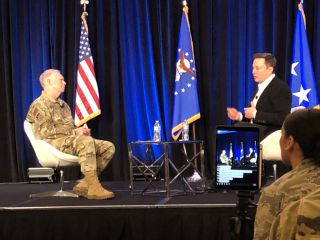SpaceX’s Starship May Fly for Just $2 Million Per Mission, Elon Musk Says – Space.com
SAN FRANCISCO — Each flight of SpaceX’s big Mars-colonizing spacecraft will have a very small price tag, if all goes according to plan.
The Starship system, which consists of a reusable 100-passenger spaceship stacked atop a huge reusable rocket known as Super Heavy, will use just $900,000 worth of propellant to get off Earth and into orbit, Elon Musk said here today (Nov. 5) at the first U.S. Air Force Space Pitch Day.
“If you consider operational costs, maybe it’ll be like $2 million” out of SpaceX’s pocket each time, Musk said during a conversation with Lt. Gen. John Thompson, commander of the Space and Missile Systems Center, Air Force Space Command, at Los Angeles Air Force Base.
“This is much less than even a tiny rocket,” Musk added. “So, it’s something that needs to be made.”
Related: SpaceX’s Starship and Super Heavy Mars Rocket in Pictures
During Space Pitch Day (which should be called Space Pitch Days, since it runs through tomorrow), companies try to sell Air Force brass on their space-related ideas. In keeping with this focus, Thompson mostly asked Musk about business stuff — how to spur innovation, how management and leadership styles shift as a company grows, and so on.
This may sound relatively dry to space geeks, but Musk injected some fun nuggets into the conversation. For example, the billionaire entrepreneur said he does “zero market research whatsoever,” striving instead to create the Platonic ideal of a rocket or car. (Musk is also CEO of electric-vehicle maker Tesla.)
If he pulls that off, then “people will want to buy it,” Musk said.

The Starship MK1 assembled at SpaceX’s build and launch facility in Texas.
(Image credit: SpaceX)
He also hyped Tesla’s new pickup truck, saying that “it looks like an armored personnel carrier from the future,” and announced that he had just finished watching the 1996 movie “Space Jam” (serially, during 15- to 20-minute morning workout stints on the treadmill).
Musk demurred when Thompson asked about his leadership qualities, saying he doesn’t consider himself an expert on leadership. Thompson urged Musk not to “sell himself short” in this regard, teeing up a self-deprecating joke that the billionaire jumped on.
“That’s true. There’s plenty of others doing that,” Musk said, referring to investors who are betting on the stock price of his companies (particularly Tesla) to fall.
Toward the end of the 40-minute conversation, Thompson gave Musk the floor to say anything he wanted to the audience of investors, engineers, entrepreneurs and military officials. The SpaceX founder and CEO took the opportunity to talk about something near and dear to his heart: the importance of fully and rapidly reusable orbital rockets.
This is the technological advance that will slash the cost of spaceflight by orders of magnitude, allowing humanity to become a truly spacefaring species, Musk has said repeatedly over the years.
“It’s absolutely profound to have a reusable rocket,” he said here today. “This is the holy grail.”
Related: Elon Musk Takes Us Inside SpaceX’s Starship Mk1 Prototype (Video)

SpaceX founder and CEO Elon Musk chats with Lt. Gen. John Thompson, commander of the Air Force Space Command’s Space and Missile Systems Center, which is based at Los Angeles Air Force Base. The conversation took place in San Francisco on Nov. 5, 2019, at the U.S. Air Force’s first Space Pitch Day.
(Image credit: MIke Wall/Space.com)
SpaceX has been working to make this vision a reality, and the company has made considerable progress. SpaceX now routinely lands and reflies the first stages of its workhorse Falcon 9 rocket, and it’s doing the same with the heavy-lift Falcon Heavy, which has three launches under its belt. The company is now also starting to recover and refly payload fairings, the protective nose cones that surround satellites during launch. (There is still work to do, however; for example, the second stage of the Falcon 9 and Falcon Heavy is still single-use hardware.)
Starship and Super Heavy fit well into this grand vision. Both vehicles (the spaceship, like the overall architecture, is known as Starship) will be fully reusable, and each individual craft will fly many times before it’s retired, Musk has said.
These missions will be quite varied. Starship and Super Heavy are designed primarily to help humanity settle Mars, the moon and other deep-space destinations, but SpaceX wants the duo to take over all of the company’s needs eventually. So, if all goes according to plan, Starship will also launch satellites (perhaps starting as early as 2021) and maybe even clean up space junk and ferry people on point-to-point trips around Earth, Musk has said.
Being able to do all of this for $2 million a pop would be revolutionary. That would be the cost of each mission for SpaceX, to be clear; we don’t yet know how much the company will charge customers for a Starship mission (or “is charging,” for Japanese billionaire Yusaku Maezawa has already booked a round-the-moon flight on the vehicle, with a target launch date of 2023).
But, for some perspective, SpaceX currently sells Falcon 9 and Falcon Heavy launches for $62 million and $90 million, respectively. And those prices are considerably lower than similar services offered by SpaceX’s competitors.
Mike Wall’s book about the search for alien life, “Out There” (Grand Central Publishing, 2018; illustrated by Karl Tate), is out now. Follow him on Twitter @michaeldwall. Follow us on Twitter @Spacedotcom or Facebook.

Need more space? Subscribe to our sister title “All About Space” Magazine for the latest amazing news from the final frontier!
(Image credit: All About Space)





